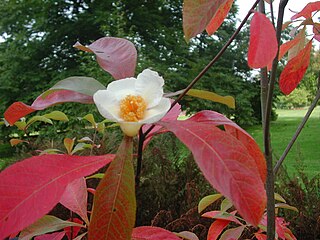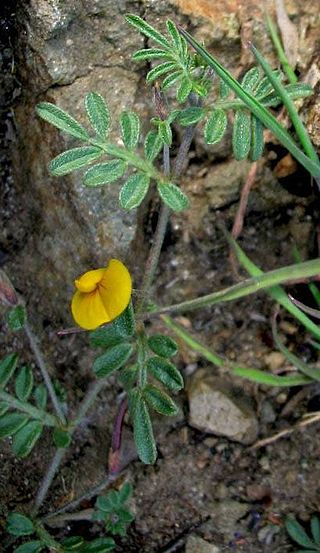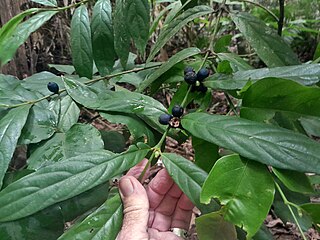
The raspberry is the edible fruit of a multitude of plant species in the genus Rubus of the rose family, most of which are in the subgenus Idaeobatus. The name also applies to these plants themselves. Raspberries are perennial with woody stems.

Ventnor is a seaside resort town and civil parish established in the Victorian era on the southeast coast of the Isle of Wight, England, eleven miles (18 km) from Newport. It is situated south of St Boniface Down, and built on steep slopes leading down to the sea. The higher part is referred to as Upper Ventnor ; the lower part, where most amenities are located, is known as Ventnor. Ventnor is sometimes taken to include the nearby and older settlements of St Lawrence and Bonchurch, which are covered by its town council. The population is 5,567 according to the 2021 Census

Rubus idaeus is a red-fruited species of Rubus native to Europe and northern Asia and commonly cultivated in other temperate regions.

Franklinia is a monotypic genus in the tea family, Theaceae. The sole species in this genus is a flowering tree, Franklinia alatamaha, commonly called the Franklin tree, and native to the Altamaha River valley in Georgia in the southeastern United States. It has been extinct in the wild since the early 19th century, but survives as a cultivated ornamental tree.

The Global Biodiversity Information Facility (GBIF) is an international organisation that focuses on making scientific data on biodiversity available via the Internet using web services. The data are provided by many institutions from around the world; GBIF's information architecture makes these data accessible and searchable through a single portal. Data available through the GBIF portal are primarily distribution data on plants, animals, fungi, and microbes for the world, and scientific names data.

Rubus strigosus, the American red raspberry or American raspberry, is a species of Rubus native to much of North America. It was often treated as a variety or subspecies of the closely related Eurasian Rubus idaeus, but is now more commonly treated as a distinct species. Many of the commercial raspberry cultivars grown for their fruit derive from hybrids between R. strigosus and R. idaeus; see Raspberry for more details.

Lasianthus is a genus of flowering plants in the family Rubiaceae. They are tropical subshrubs, shrubs, or rarely, small trees. They inhabit the understory of primary forests.
Lasianthus macrocalyx, synonym Lasianthus grandifolius, is a species of flowering plant in the family Rubiaceae, endemic to Tanzania. It was first described by Karl Moritz Schumann in 1900.
Lasianthus rhinophyllus is a species of plant in the family Rubiaceae. It is endemic to Sri Lanka. The name may also be spelt Lasianthus rhizophyllus.
Syzygium cordifolium is a species of plant in the family Myrtaceae. It is endemic to Sri Lanka.

Erigeron strigosus is a species of flowering plant in the family Asteraceae known by the common names prairie fleabane, common eastern fleabane, and daisy fleabane.

Acmispon strigosus, synonyms Lotus strigosus and Ottleya strigosa, is a flowering plant in the pea family (Fabaceae), native to the southwestern United States and northern Mexico. It is known as stiff-haired lotus or strigose bird's-foot trefoil.
Pittosporum ceylanicum is a species of plant in the Pittosporaceae family. It is endemic to Sri Lanka.

Hedyotis lawsoniae is a species of flowering plant in the family Rubiaceae, endemic to Sri Lanka.
Lasianthus walkerianus is a species of plant in the family Rubiaceae. It is endemic to Sri Lanka.

Lasiantheae is a tribe of flowering plants in the family Rubiaceae and contains 239 species in 3 genera. Its representatives are found in Central America, the Caribbean, tropical Africa, and tropical and subtropical Asia.
Eucinetus strigosus is a species of plate-thigh beetle in the family Eucinetidae. It is found in North America.
Finlaysonia is a genus of flowering plants in the dogbane family Apocynaceae, found from Sri Lanka, India, through Southeast Asia, New Guinea, northern Australia, the Philippines, and Palau. They tend to be vines or climbers and prefer to live on limestone, alongside rivers, or in mangrove swamps.

Gloiodon strigosus is a species of fungus belonging to the family Bondarzewiaceae.

Lasianthus chlorocarpus, commonly known as blue rubi, is a plant in the family Rubiaceae native to parts of Malesia, Papuasia and Australia. It is an evergreen shrub growing up to 2 m high in well developed rainforest.












